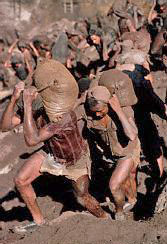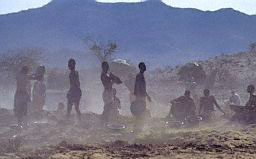|
Chapter Eleven
MUTINY OF THE
ANUNNAKI
Clarifying Misconceptions.... "Lower World" = "Arali" = Southwestern
African Connection.
"After Enlil arrived on Earth in person, "Earth Command" was
transferred out of Enkiís hands. It was probably at this point that
Enkiís epithet or name was changed to E.A ("lord waters") rather
than "lord earth."
"....A separation of powers was agreed upon:
-
Anu was to stay in the
heavens and rule over the Twelfth Planet
-
Enlil was to command the
lands
-
Enki was put in charge of the
AB.ZU (apsu in Akkadian)
"....In other instances,
Enlilís domain was referred to as the Upper
World, and Eaís as the Lower World; again, the scholars assumed that
Enlil controlled Earthís atmosphere while Ea was ruler of the
"subterranean waters" - the Greek like Hades the Mesopotamians
supposedly believed in. Our own term abyss (which derives from
apsu)
denotes deep, dark, dangerous waters in which one can sink and
disappear. Thus, as scholars came upon Mesopotamian texts describing
this Lower World, they translated it as Unterwelt ("underworld") or
Totenwelt ("world of the dead"). Only in recent years the
Sumerologists mitigated the ominous connotation somewhat by using
the term netherworld in translation.
It was here that
Inanna/Ishtar had gone in search for Dumuzi,
biblically known as god Tammuz, (one of Enkiís sons).
Ishtar had a
most celebrated love affair with Dumuzi and when he disappeared, she
went in his search to the Lower World.
"....Ishtar went there neither dead nor against her will - she went
alive and uninvited, forcing her way in by threatening the
gatekeeper:
If thou openest not the gate so that I cannot enter,
I will smash the door, I will shatter the bolt,
I will smash the doorpost, I will move the doors.
Seven gates were opened to
Ishtar.
Mr. Sitchin explains diverse events which
occurred in the Lower
World, like Ereshkigalís anger on seeing her sister Inanna. Love
affairs between Ereshkigal and Nergal, a great son of
Ea.
"The events recounted do not suggest a
Land of the Dead. Quite the
contrary: it was a place the gods could enter and leave, a place of
lovemaking, a place important enough to be entrusted to a
granddaughter of Enlil and a son of Enki. "....The place was far and
difficult to reach, to be sure, and a somewhat "restricted area" but
hardly a "place of no return." Like Inanna other leading deities
were reported going to and coming from, this Lower World.
"Far from being a dark and desolate place, it was described as a
bright place with flowing waters.
A rich land, beloved of Enki;
Bursting with riches, perfect in fullness...
Whose mighty river rushes across the land.
"...It is evident from Sumerian sources that such flowing waters
indeed existed - not in Sumer and its flatlands, but in the
Great
Below....
"....A long text, little understood because no intact version has
been found, deals with some major dispute between Ira (Nergalís
title as Lord of the Lower World) and his brother Marduk. In the
course of the dispute, Nergal left his domain and confronted
Marduk
in Babylon; Marduk, on the other hand threatened: "To the
Apsu will
I descend, the Anunnaki to supervise ... my raging weapons against
them I will raise." To reach the Apsu, he left the Land of
Mesopotamia and travelled over "waters that rose up." His
destination was Arali in the "basement" of Earth, and the texts
provide a precise clue as to where this "basement" was:
In the distant sea,
100 beru of water (away) ...
the ground of Arali (is) ...
It is where the Blue Stones cause ill,
Where the craftsman of Anu
the Silver Axe carries, which shines as the day.
"...The texts indicate that
Arali was situated west and south of
Sumer. A ship travelling two to three thousand miles (one hundred
beru meant two hundred hours of sailing) in a southwesterly
direction from the Persian Gulf could have only one destination: the
coast of southern Africa.
"Only such a conclusion can explain the terms
Lower World, as
meaning the southern hemisphere, where the Land of Arali was, as
contrasted with the Upper World, or northern hemisphere, where
Sumer
was.
"...Many cylinder seals, depicting animals peculiar to the area (of
southern Africa), (such as the zebra or ostrich), jungle scenes, or
rulers wearing leopard skins in the African tradition, attest to an
"African connection."
Next: What other interests did the
Nefilim have in this part of
Africa? But First.... More on
the African Connection.... Tablet Of Wisdom....
"What interest did the
Nefilim have in this part of Africa,
diverting to it the scientific genius of Ea and granting to the
important gods in charge of the land a unique "Tablet of Wisdom?"
"....Literally, the term AB.ZU meant "primeval deep source" - not
necessarily of waters. According to Sumerian grammatical rules,
either of two syllables of any term could precede the other without
changing the wordís meaning with the result that AB.ZU and ZU.AB
meant the same thing.... for za-ab has always meant and still means
"precious metal," specifically "gold," in Hebrew and its sister
languages.
"The Sumerian pictograph for AB.ZU was that of an excavation deep
into Earth, mounted by a shaft. Thus Ea was not the lord of an
indefinite "watery deep" but the god in charge of the
exploitation
of Earthís minerals!
"....Some Mesopotamian hymns to
Ea exalt him as Bel Nimiki,
translated "lord of wisdom"; but the correct translation should
undoubtedly be "lord of mining." Just as the Tablet of Destinies at
Nippur contained orbital data, it follows that the
Tablet of Wisdom
entrusted to Nergal and Ereshkigal was in fact a "Tablet of Mining"
a "data bank" pertaining to the mining operations of the
Nefilim.
"As Lord of the Abzu, Ea was assisted by another son, the god
GI.BIL
("he who burns the soil") who was in charge of fire and smelting.
Earthís Smith, he was usually depicted as a young god whose
shoulders emit red-hot rays or sparks of fire, emerging from the
ground or about to descend into it.
The texts state that Gibil was steeped by
Ea in "wisdom" meaning
that Ea had taught him mining techniques.
"....The ores were taken to
Bad-Tibira, whose name literally meant
"the foundation of metalworking." Smelted and refined, the ores were
cast into ingots whose shape remained unchanged throughout the
ancient world for millennia. Such ingots were actually found at
various Near East excavations, confirming the reliability of
Sumerian pictographs....
"....Extensive references to gold and other metals in ancient texts
suggest familiarity with metallurgy from the earliest times. A
lively metal trade existed at the very beginning of civilization,
the result of knowledge bequeathed to Mankind by the gods, who, the
texts state, had engaged in mining and metallurgy long before Manís
appearance....
Tubal-cain was (according to the Bible) an "artificer of gold and
copper and iron" long before the Deluge.
After an extensive explanation of how archaeologists and scientists
have studied the area of the minings, Mr Sitchin quotes from
Dr.
Kenneth Oakley, former head anthropologist of the Natural History
Museum in London:
"It throws an important light to the origins of Man.... it is now
possible that southern Africa was the evolutionary home of Man, the
"birthplace" of Homo sapiens.
"As we shall show, it was indeed there that
modern Man appeared on
Earth, through a chain of events triggered by the godsí search for
metals.
THE HARD TOIL OF GOLD
MINERS
But First.... Search
for Metals....
"Gold,
silver, and copper are all native elements of the gold group.
They fall into the same family in the periodic classification by
atomic weight and number; they have similar crystallographic,
chemical, and physical properties all are soft, malleable, and
ductile. Of all known elements, these are the best conductors of
heat and electricity.
"Of the three, gold is the most durable, virtually indestructible.
Though best known for its use in money and in jewelry or fine
artifacts, it is almost invaluable in the electronics industry. A
sophisticated society requires gold for microelectronic assemblies,
guidance circuitry, and computer "brains."
"....Gold, which we call the royal metal, was in fact the
metal of
the gods....
"....The Nefilim, it appears, came to Earth for
gold and its related
metals. They may also have come for other rare metals - such as
platinum (abundant in southern Africa), which can power fuel cells
in an extraordinary manner. And the possibility should not be ruled
out that they came to Earth for sources of radioactive minerals,
such as uranium or cobalt - the Lower Worldís "blue stones that
cause ill," which some texts mention. Many depictions show Ea - as
the God of Mining - emitting such powerful rays as he exits from a
mine that the gods attending him have to use screening shields; in
all these depictions, Ea is shown holding a minerís rock saw.
"Though Enki was in charge of the first landing party and the
development of the Abzu, credit for what was accomplished - as the
case should be with all generals - should not go to him alone. Those
who actually did the work, day in, day out, were the lesser members
of the landing party, the Anunnaki."
"....The ancient texts described
the Anunnaki as the rank-and-file
gods who had been involved in the settlement of Earth - the gods
"who performed the tasks." The Babylonian "Epic of Creation"
credited Marduk with giving the Anunnaki their assignments. (The
Sumerian original, we can safely assume, named Enlil as the god who
commanded these astronauts).
Assigned to Anu, to heed his instructions,
Three hundred in the heavens he stationed as a guard;
the ways of Earth to define from the Heaven;
And on Earth,
Six hundred he made reside.
After he their instructions had ordered,
to the Anunnaki of Heaven and Earth
he
allotted their assignments.
"The texts reveal that
three hundred of them - the Anunnaki of
Heaven, or "Igigi - were true astronauts who stayed aboard the
spacecraft without actually landing on Earth. Orbiting Earth, these
spacecraft launched and received the shuttlecraft to and from Earth.
As chief of the "Eagles"
Shamash was a welcome and heroic guest
aboard the "mighty great chamber in heaven" of the Igigi....
"....Staying aloft, the Igigi were apparently never encountered by
Mankind. Several texts say that they were "too high up for Mankind,"
as a consequence of which "they were not concerned with the people."
The Anunnaki, on the other hand, who landed and stayed on Earth,
were known and revered by Mankind. The texts that state that "the
Anunnaki of Heaven ... are 300" also state that "the Anunnaki of
Earth are 600."
Mr. Sitchin explains, quoting from some texts, that
the Nefilim
would come from the Twelfth Planet in parties of fifty. He
concludes:
"....It is, we believe, quite conceivable that the
Nefilim arrived
on Earth in groups of fifty. As the visits to Earth became regular,
coinciding with the opportune launching times from the Twelfth
Planet, more Nefilim would arrive. Each time, some of the earlier
arrivals would ascend in an Earth module and rejoin the spaceship
for a trip home. But, each time, more Nefilim would stay on Earth,
and the number of Twelfth Planet astronauts who stayed to colonize
Earth grew from the initial party of fifty to the "600 who on Earth
settled."
"....How did the Nefilim expect to achieve their mission - to mine
on Earth its desired minerals, and ship the ingots back to the
Twelfth Planet - with such a small number of hands?
|
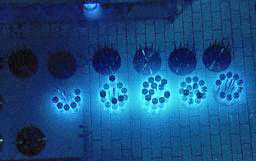
Minerals and
Metals the Anunnaki came to Earth for? |

Cobalt Vase from
shipwreck |

COBALT 60
RADIOACTIVE ISOTOPS
"....Those shining blue stones....." |
|

Areal view
of Uranium mine |
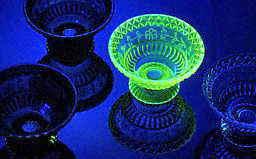
Fluorescent
Bowl |
|

GOLD INGOTS
|
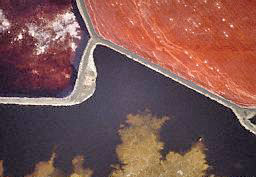
Mineral
Formations in Lake Magadi |
They cried: No
More!... Leading to The Creation of Man = Primitive Worker =
Lulu....
"A famous seal now on exhibit at the
Louvre Museum shows Ea with his
familiar flowing waters, except that the waters seem to emanate
from, or be filtered through, a series of laboratory flasks. Such an
ancient interpretation of Eaís association with waters rises the
possibility that the original hope of the Nefilim was to obtain
their minerals from the sea. The ocean waters do contain vast
quantities of gold and other minerals....
"The ancient texts refer
repeatedly to a type of ship used by the
gods called elippu tebiti ("sunken ship - what we now call a
submarine). We have seen the "fish-men" that were assigned to
Ea. Is
this evidence of efforts to dive to the depths of the oceans an
retrieve their mineral riches?
"The Land of the Mines, we have noted, was earlier called
A.RA.LI -
"place of the waters of the shiny lodes....."
"....If this were the plans of the
Nefilim, they apparently came to
naught. For, soon afterwards they had established their first
settlements, the few hundred Anunnaki were given an unexpected and
most arduous task: to go down into the depths of the African soil
and mine the needed minerals there.
"In later times,
Babylonian and Assyrian texts disclose, men - young
and old - were sentenced to hard labour in the mines of the
Lower
World. Working in darkness and eating dust as food, they were doomed
never to return to their homeland. This is why the Sumerian epithet
for the land - KUR.NU.GI.A - acquire the interpretation "land of no
return"; its literal meaning was "land where gods-who-work, in deep
tunnels pile up [the ores]." For the time when the Nefilim settled
Earth, all the ancient sources attest, was a time when Man was not
yet on Earth, and in the absence of Mankind, the few
Anunnaki had to
toil in the mines. Ishtar, on her descent to the Lower World,
described the toiling Anunnaki as eating food mixed with clay and
drinking water fouled with dust.
"Against this background, we can fully understand a long epic text
named (after its opening verse, as was the custom), "When the gods,
like men, bore the work."
"....They also explain the
circumstances that led to the mutiny of the Anunnaki.
When the gods, like men,
bore the work and suffered the toil -
the toil of the gods was great,
the work was heavy,
the distress was much.
"....Seven cities were established, and the text refers to
seven
Anunnaki who were city commanders. Discipline must have been strict,
for the text tells us "The seven Great Anunnaki were making the
lesser gods suffer the work."
"....For a long time - for forty "periods," to be exact - the
Anunnaki "suffered the toil"; and they cried: No more!
They were complaining, backbiting,
Grumbling in the excavations.
"The occasion for the mutiny appears to have been a visit by
Enlil
to the mining area. Seizing the opportunity, the Anunnaki said to
one another:
Let us confront our ... the Chief Officer,
That he may relieve us of our heavy work.
The king of the gods, the hero Enlil,
Let us unnerve him in his dwelling!
"A leader or organizer of the mutiny was soon found. He was the
"chief officer of old time," who must have held a grudge against the
current chief officer. His name, regrettably, is broken off; but his
inciting address is quite clear:
Now proclaim war;
Let us combine hostilities and battle.
"The description of the
mutiny is so vivid that scenes of the
storming of the Bastille come to mind:
The gods heeded his words,
They set fire to their tools;
Fire to their axes they put;
They troubled the god of mining in the tunnels;
They [held] him as they went
to the gate of the hero Enlil.
"The drama and tension of the unfolding events are brought to life
by the ancient poet:
It was night, half-way through the watch.
His house was surrounded -
but the god, Enlil, did not know.
Kalkal [then] observed it, was disturbed.
He slid the bolt and watched....
Kalkal roused Nusku;
they listened to the noise of....
Nusku roused his lord -
he got him out of his bed, [saying]:
"My lord, your house is surrounded,
battle has come right up to your gate."
A Council of the Gods was
advised, Anu himself attended, he
suggested an inquiry.
At the question of Nusku, when he confronted the Anunnaki, "Who is
the provoker of hostilities?"
The Anunnaki stood together:
"Every single one of us gods has war declared!
We have our ... in the excavations;
Excessive toil has killed us,
Our work was heavy, the distress much."
"When Enlil heard
Nuskuís report of these grievances, "his tears
flowed."
"....Anu sided with the Anunnaki.
"...Encouraged by his fatherís words,
Ea also "opened his mouth,"
and repeated Anuís summation. But he had a solution to offer: Let a
lulu, a "Primitive Worker,"
be created!
While the Birth Goddess is present,
Let her create a Primitive Worker;
Let him bear the yoke....
Let him carry the toil of the gods!
"The suggestion that a "Primitive Worker"
be created so that he
could take over the burden of work of the Anunnaki was readily
accepted. Unanimously, the gods voted to create "The Worker."
íManí shall be his name," they said....
"....The Nefilim, having arrived on
Earth to set up their colonies,
had created their own brand of slavery, not with slaves imported
from another continent, but with Primitive Workers fashioned by the Nefilim themselves.
"A mutiny of the gods had led to the creation of Man.
Return
Chapter Twelve
THE CREATION
OF MAN
"The assertion, first recorded and then transmitted by the
Sumerians, that "Man" was created by the
Nefilim, appears at first
sight to clash both with the theory of evolution and with the
Judeo-Christian tenets based on the Bible. But in fact, the
information contained in the Sumerian texts - and only that
information - can affirm the validity of the theory of evolution and
the truth of the biblical tale - and show that there really is no
conflict at all between the two.
"....The Sumerian texts state that when the
Nefilim first came to
Earth, the arts of grain cultivation, fruit planting, and cattle
raising had not yet extended to Earth. The biblical account likewise
places the creation of Man in the sixth "day" of phase of the
evolutionary process....
"....All the Sumerian texts assert that the gods created
Man to do
their work. Putting the explanation in words uttered by Marduk, the
Creation epic reports the decision:
I will produce a lowly Primitive;
"Man" shall be his name.
I will create a Primitive Worker;
He will be charged with the service of the gods,
that they might have their ease.
"....That man was created to be a
servant of the gods did not strike
to ancient peoples as a peculiar idea at all. In biblical times, the
deity was "Lord," "Sovereign," "King," "Ruler," "Master." The term
that is commonly translated as "worship" was in fact "avod"
("work"). Ancient and biblical Man did not "worship" his god;
he
worked for him.
"....In the Sumerian versions, the decision to create
Man was
adopted by the gods in their Assembly. Significantly, the Book of
Genesis - purportedly exalting the achievements of a
sole Deity -
uses the plural Elohim (literally, "deities") to denote "God," and
reports an astonishing remark:
And Elohim said:
"
Let us make Man in our image, after our likeness."
"Whom did the sole but plural Deity address, and who were the "us"
in whose plural image and plural likeness Man was to be made? The
book of Genesis does not provide the answer. Then, when Adam and
Eve ate of the fruit of the Tree of Knowing,
Elohim issued a warning to
the same unnamed colleagues: "Behold, Man has become as one of us,
to know good and evil."
"Since the biblical story of Creation, like the other tales of
beginnings in Genesis, stems from Sumerian origins, the answer is
obvious. Condensing the many gods into a Supreme Deity, the biblical
tale is but an edited version of the Sumerian reports of the
discussions in the Assembly of the Gods.
"The Old Testament took pains to make clear that
Man was neither a
god nor from the heavens. "The Heavens are the Heavens of the Lord,
unto Mankind Earth He hath given." The new being was called "the
Adam" because he was created of the "adama," the
Earthís soil. He
was, in other words, "the Earthling."
"Lacking only certain "knowing" and a divine span of life, the
Adam
was in all other respects created in the image (selem) and likeness
(dmut) of his Creator(s). The use of both terms in the texts was
meant to leave no doubt that
"Man was similar to the Gods both physically and emotionally,
externally and internally.
"....Although the biblical admonition against the worship of pagan
images gave rise to the notion that the Hebrew God had neither image
nor likeness, not only the Genesis tale but other biblical reports
attest to the contrary. The god of the ancient Hebrews could be seen
face-to-face, could be wrestled with, could be heard and spoken to,
he had a head and feet, hands and fingers, and a waist. The biblical
God and his emissaries looked like men and acted like men - because
men were created to look like and act like the gods.
"But in this very simplicity lies a great mystery. How could a new
creature possibly be a virtual physical, mental, and emotional
replica of the Nefilim? How, indeed, was Man created?
"....In November 1859,
an English Naturalist by the name of Charles Darwin published a
treatise called "On the Origin of Species by Means of Natural
Selection," or the "Preservation of Favored Races in the Struggle
for Life."
"....The Christian world had been jostled earlier when, from 1788
on, noted geologists had begun to express their belief that Earth
was of great antiquity, much, much greater than the roughly 5,500
years of the Hebrew calendar. Nor was the notion of evolution as
such the explosive: Earlier scholars had noted such a process, and
Greek scholars as far back as the fourth century B.C. compiled data
on the evolution of animal and plant life.
"Darwinís shattering bombshell was the conclusion that all living
things - Man included - were products of evolution. Man, contrary to
the then-held belief, was not generated spontaneously.
"....Evolution cannot account for the
appearance of Homo sapiens,
which happened virtually overnight in terms of the millions of years
evolution requires, and with no evidence of earlier stages that
would indicate a gradual change from Homo erectus.
"THE HOMINID OF THE GENUS
HOMO IS A PRODUCT OF EVOLUTION. BUT HOMO
SAPIENS IS THE PRODUCT OF SOME SUDDEN, REVOLUTIONARY EVENT. HE
APPEARED INEXPLICABLY SOME 300,000 YEARS AGO,
MILLIONS OF YEARS TOO SOON."
"The scholars have no explanation, but we do. The Sumerian and
Babylonian texts do. The Old Testament does.
"Homo sapiens -
modern Man - was brought about by the ancient gods.
"....As we have already shown, the orbit of the Nefilimís planet
equaled a shar, or 3,600 Earth years. Forty shars, or 144,000 Earth
years, after their landing, the Anunnaki protested, "No more!" If
the Nefilim first landed on Earth, as we have concluded, some
450,000 years ago, then the creation of Man took place some
300,000
years ago!
"The Nefilim did not create the mammals or the primates or
the hominids. "The Adam" of the Bible was not the
genus Homo, but
the being who is our ancestor - the first Homo sapiens. It is
modern
Man as we know him that the Nefilim created."
"The key to understand this crucial fact lies in the tale of a
slumbering Enki, aroused to be informed that the gods had decided to
form an adamu, and that it was his task to find the means. He
replied:
"The creature whose name you uttered -
"IT EXISTS!"
"....and he added: "Bind upon it" - on the creature that already
exists - "the image of the gods."
"Here, then, is the answer to the puzzle:
The Nefilim did not
"create" Man out of nothing; rather, they took an existing creature
and manipulated it, to "bind upon it" the "image of the gods.
Mr. Z. Sitchin gives an overview, that at their arrival on
Earth,
435,000 years ago, the Nefilim very possibly were observing the
primitive mammals, or even captured this interesting primates.
"Many cylinder seals have been found that depict this
shaggy ape-man
among his animal friends.
"....Faced with the need for manpower, resolved to obtain a
Primitive Worker, the Nefilim saw a ready-made solution: to
domesticate a suitable animal.
"The animal was available - but
Homo erectus posed a problem. On the
one hand, he was too intelligent and wild to become simply a docile
beast of work. On the other hand, he was not really suited to the
task.... He needed enough cleverness and understanding to be an
obedient and useful "amelu" - a serf.
"....Observing the various forms of life on Earth, the
Nefilim and
their chief scientist, Ea, needed little time to realize what had
happened: During the celestial collision, their planet had seeded
Earth with its life. Therefore, the being that was available was
really akin to the Nefilim - though in a less evolved form.
"The process that
Ea recommended in order to achieve a quick
evolutionary advancement of Homo erectus was, we believe,
genetic
manipulation.
"We should assume that
the Nefilim - being capable of space travel 450,000 years ago - were
also equally advanced, compared to us today, in the field of life
sciences. We should also assume that they were aware of the various
alternatives by which two preselected sets of chromosomes could be
combined to obtain a predetermined genetic result; and that whether
the process was akin to cloning, cell fusion,
genetic transplant,
or methods as yet unknown to us, they knew these processes and could
carry them out, not only in the laboratory flask but also with
living organisms.
"....It is quite conceivable that before resorting to the creation
of a being in their own image, the Nefilim attempted to come up with
a "manufactured servant" by experimenting with other alternatives:
the creation of a hybrid ape-man-animal. Some of these artificial
creatures may have survived for a while but were certainly unable to
reproduce....
"Sumerian texts, too, speak of deformed humans created by
Enki and
the Mother Goddess (Ninhursag), in the course of their efforts to
fashion a perfect Primitive Worker.
"....But finally the perfect
Man was achieved, the one Enki named
Adapa; the Bible, Adam; our scholars,
Homo sapiens. This being was
so much akin to the gods that one text even went so far as to point
out that the Mother Goddess gave to her creature, Man, "a skin as
the skin of a god" - a smooth, hairless body, quite different from
that of the shaggy ape-man.
"With this final product, the
Nefilim were genetically compatible
with the daughters of Man and able to marry them and have children
by them. But such compatibility could exist only if Man had
developed from the same "seed of life" as the
Nefilim. This, indeed,
is what ancient texts attest to.
"....Called upon to fashion a man, the
Mother Goddess "Washed her
hands, pinched off clay, mixed it in the steppe." (It is fascinating
to note here the sanitary precautions taken by the goddess. She
"washed her hands." We encounter such clinical measures and
procedures in other creation texts as well).
"Following the mixing of the "blood" and "clay," the childbearing
phase would complete the bestowal of a divine "imprint" on the
creature.
The new bornís fate thou shalt pronounce;
Ninki will fix upon it the image of the gods;
And what it will be is "Man."
Ninki being a spouse of
Enki.
"Scholars have surmised that references to Adapa as a "son" of
Ea
implied that the god loved this human so much that he adopted him.
But in the same text Anu refers to Adapa as "the human offspring of
Enki." It appears that the involvement of Enkiís spouse in the
process of creating Adapa, the "model Adam," did create some
genealogical relationship between the new Man and his god: It was
Ninki who was pregnant with Adapa!
"Ninki blessed the new being and presented it to
Ea."
"....Once Adapa/Adam proved to be the right creature, he was used as
the genetic model or "mold" for the creation of duplicates, and
those duplicates were not only male but male and female. As we
showed earlier, the biblical "rib" from which Woman was fashioned
was a play on words on the Sumerian TI ("rib" and "life") -
confirming that Eve was made of Adamís "lifeís essence."
Mr. Sitchin does not leave the tales of the Old Testament out. He
compares them, and indicates that the biblical texts are
condensations of the original Sumerian sources, sometimes creating
contradictions.
But Adam had duplicates, and Mr. Sitchin provides the several verses
from texts where it is indicated how 14 female were used to deposit
the "mixed clay" in their womb. There were surgical procedures, with
hygienic measures.
How was the Creation of Man accomplished?
"The text "When the gods as men" contains a passage whose purpose
was to explain why the "blood" of a god had to be mixed into the
"clay." The "divine" element required was not simply the dripping
blood of a god, but something more basic and lasting. The god that
was selected, we are told, had TE.E.MA - a term the leading
authorities on the text (W.G. Lambert and A.R. Millard of Oxford
University) translate as "personality." But the ancient term is much
more specific; it literally means "that which houses that which
binds the memory." Further on, the same term appears in the Akkadian
version as etemu, which is translated as "spirit."
"In both instances we are dealing with that "something" in the
blood
of the god that was the repository of his individuality. All these,
we feel certain, are but roundabout ways of stating that what Ea was
after, when he put the godís blood through a series of "purifying
baths" was the godís genes.
"The purpose of mixing this divine element
thoroughly with the
earthly element was also spelled out:
In the clay, god and Man shall be bound,
to a unity brought together;
So that to the end of days
the Flesh and the Soul
which in a god have ripened -
that Soul in a blood-kingship be bound;
As its Sign life shall proclaim.
So that this not be forgotten,
Let the "Soul" in a blood-kingship be bound.
"These are strong words, little understood by scholars.
The text states that the godís blood was mixed into the clay so as
to bind god and Man genetically "to the end of days" so that both
the flesh ("image") and the soul ("likeness") of the gods would
become imprinted upon Man in a kingship of blood that could never be
severed.
"....Te evidence of the ancient texts, Mesopotamian as well as
biblical, suggests that the process adopted for merging two sets of
genes - those of a god and those of
Homo erectus - involved the use
of male genes as the divine element and female genes as the earthly
element. Repeatedly asserting that the Deity created
Adam in his
image and in his likeness, the Book of Genesis later describes the
birth of Adamís son Seth in the following words:
"And Adam lived a hundred and thirty years,
and had an offspring
in his likeness and after his image;
and he called his name Seth."
"The terminology is identical to that used to describe the creation
of Adam by the Deity. But Seth was certainly born to
Adam by a
biological process - the fertilization of a female egg by the male
sperm of Adam, and ensuing conception, pregnancy, and birth.
"....If the "clay" onto which the godly element was mixed was an
earthly element - as all texts insist - then the only possible
conclusion is that the male sperm of a god - his genetic material -
was inserted into the egg of an ape-woman!
"The Akkadian term for the "clay" - or, rather, "molding clay" - is
tit. But its original spelling was TI.IT ("that which is with
life"). In Hebrew, tit means "mud"; but its synonym is
bos, which
share a root with bisa ("marsh") and besa ("egg").
"The story of Creation is replete with plays on words. We have seen
the double and triple meanings of Adam-adama-adamtu-dam. The epithet
for the Mother Goddess, NIN.TI, meant both "lady of life" and "lady
of the rib." Why not, then, bos-bisa-besa ("clay-mud-egg") as a play
of words for the female ovum?
"....The texts make abundantly clear that while
Ea built a brick
house by the water in Eridu, in the Abzu (southern Africa) he built
a house adorned with precious stones and silver. It was there that
his creature, Man, originated.
"One can even conclude from the various texts that the
creation of
Man caused a rift among the gods. It would appear that at least at
first the new Primitive Workers were confined to the Land of Mines.
As a result, the Anunnaki who were toiling in Sumer proper were
denied the benefits of the new manpower.
But Enlil heard the plea of the
Anunnaki in Sumer and by force
brought manpower from Abzu to do the toiling.
Return
Chapter Thirteen
THE END OF ALL
FLESH
The "Knowing" of Adam and Eve....
"The only complete account of the events that befell
Man following
his transportation to the Abode of the Gods in Mesopotamia is the
biblical tale of Adam and Eve in the Garden of Eden:
Explaining that the
Adam was created by the Deity Yahweh, and the
placing of the two Trees, the last five verses mention:
"Of every tree of the orchard eat you shall;
but of the Tree of Knowing good and evil
thou shall not eat of it;
for on the day that thou eatest thereof
thou shall surely die."
"Though two vital fruits were available, the
Earthlings were
prohibited from reaching only for the fruit of the Tree of Knowing.
The Deity - at that point - appeared unconcerned that Man might try
to reach for the Fruit of Life. Yet Man could not adhere even to
that single prohibition, and tragedy followed.
"The idyllic picture soon gave way to dramatic
developments, which
biblical scholars and theologians call the Fall of Man. It is a tale
of unheeded divine commandments, divine lies, a wily (but
truth-telling) Serpent, punishment, and exile.
"Appearing from nowhere, the
Serpent challenged Godís solemn
warnings.
"....Reading and rereading the concise yet precise tale, (the
discussion of the Serpent, Adam and Eve), one cannot help wondering
what the whole confrontation was about. Prohibited under threat of
death from even touching the Fruit of Knowing, the two Earthlings
were persuaded to go ahead an eat the stuff, which would make them
"knowing" as the Deity. Yet all that happened was a sudden awareness
that they were naked.
"The State of nakedness was indeed a major aspect of the whole
incident.... Not only were they naked, they were unaware of the
implication of such nakedness....
"....The continuing biblical narrative confirms the connection
between nakedness and the lack of knowing, for it took the Deity no
time at all to put the two together:
"And He said:
"Who told thee that thou are naked?
Has thou eaten of the tree,
whereof I commanded thee not to eat?"
"Admitting the truth, the
Primitive Worker blamed his female mate,
who, in turn, blamed the Serpent....
"....While no Mesopotamian counterpart of the biblical tale has yet been found, there can be little doubt that the tale - like
all the biblical material concerning Creation and Manís prehistory -
was of Sumerian origin. We have the locale: the Abode of the Gods in
Mesopotamia. We have the telltale play on words in Eveís name ("she
of life," "she of rib.") And we have two vital trees, the Tree of
Knowing and the Tree of Life, as in Anuís abode.
"Even the words of the Deity reflect a Sumerian origin, for the sole
Hebrew Deity has again lapsed into the plural, addressing divine
colleagues, who were featured not in the Bible but in Sumerian texts:
Then did the Deity Yahweh say:
"Behold, the Adam has become as one of us,
to know good and evil.
And now might he not put forth his hand
and partake also of the Tree of Life,
and eat, and live forever?"
"And the Deity
Yahweh expelled the Adam from the orchard of
Eden.
"As many early Sumerian depictions show, there had been a time when
Man, as a Primitive Worker, served his gods stark naked. He was
naked whether he served the gods their food and drink, or toiled in
the fields or on construction jobs.
Mr. Z. Sitchin explains that
Man had been not given the "knowing"
that he was different than the animals.
"Did the lack of "knowing," then, mean that, naked as an animal, the
newly fashioned being also engaged in sex as, or with, the animals?
Some early depictions indicate that this was indeed the case.
"....If this "knowing" meant only that Man had come to recognize
that having sex with animals was uncivilized or evil, why were Adam
and Eve punished for giving up sodomy? The Old Testament is replete
with admonitions against sodomy, and it is unconceivable that the
learning of a virtue would cause divine wrath.
"The "knowing" that
Man obtained against the wishes of the Deity - or one of the deities
- must have been of a more profound nature. It was something good
for Man, but something his creators did not wish him to have.
"Throughout the
Old
Testament the term "to know" is used to denote sexual intercourse,
mostly between a man and his spouse for the purpose of having
children. The tale of Adam and Eve in the Garden of Eden is the
story of a crucial step in Manís development: the acquisition of the
ability to procreate.
"That the first representatives of
Homo sapiens were incapable of
reproduction should not be surprising. Whatever method the Nefilim
had used to infuse some of their genetic material into the
biological makeup of the hominids they selected for the purpose, the
new being was a hybrid, a cross between two different, if related,
species. Like a mule (a cross between a mare and a donkey), such
mammal hybrids are sterile.
"Were the Nefilim, at first, simply producing "human mules" to suit
their requirements?
There are depictions on a rock in the mountains of southern
Elam,
which give indications of mass reproduction of beings all looking
alike. Mr. Z. Sitchin explains this in detail and the graphic is
shown on the book.
"The inability of hybrids to procreate, it has been discovered
recently, stems from a deficiency in the reproductive cells. While
all cells contain only one set of hereditary chromosomes, Man and
other mammals are able to reproduce because their sex cells (the
male sperm, the female ovum) contain two sets each. But this unique
feature is lacking in hybrids. Attempts are now being made through
genetic engineering to provide hybrids with such a double set of
chromosomes in their reproductive cells, making them sexually
"normal."
"Was that what the god whose epithet was "The Serpent" accomplished
for Mankind?
"The biblical Serpent surely was not a lowly, literal snake - for he
could converse with Eve, he knew the truth about the matter of
"knowing," and he was of such high stature that he unhesitatingly
exposed the deity as a liar. We recall that in all ancient
traditions, the chief deity fought a Serpent adversary - a tale
whose roots undoubtedly go back to the Sumerian gods.
"....The possibility that the biblical antagonists - the
Deity and
the Serpent - stood for Enlil and Enki seems to us entirely
plausible.
"....Although Enki had been the true pioneer, while
Enlil stayed at
the comfortable Mission control Center at Nippur,
Enki was sent to
organize the mining operations in the Lower World. The mutiny of
the
Anunnaki was directed at Enlil and his son Ninurta; the god who
spoke out for the mutineers was Enki. It was Enki who suggested, and
undertook, the creation of Primitive Workers; Enlil had to use force
to obtain some of this wonderful creatures. As the Sumerian texts
recorded the course of human events, Enki as a rule emerges as
Mankindís protagonist, Enlil as its strict discipliner if not
outright antagonist. The role of a deity wishing to keep the new
humans sexually suppressed, and of a deity willing and capable of
bestowing on Mankind the fruit of "knowing," fit
Enlil and Enki perfectly.
"Once more, Sumerian and biblical plays on words come to our aid.
The biblical term for "Serpent" is nahash which does mean "snake."
But the word comes from the root NHSH, which means "to decipher, to
find out"; so that nahash could also mean, "he who can decipher, he
who finds things out," an epithet befitting Enki, the chief
scientist, the God of Knowledge of the Nefilim.
"....Most pertinent to our findings is the fact that in the
Mesopotamian texts, the god who eventually granted "knowledge" to
Adapa was none other than Enki:
Wide understanding he perfected for him....
Wisdom, [he had given him]....
To him he had given Knowledge;
Eternal Life he had not given him.
Eventually:
"Cast out of the Abode of the Gods, doomed to a mortalís life, but
able to procreate, Man proceeded to do just that.
"....The Sumerian texts, which describe the early stages when the
gods were alone in Sumer, describe with equal precision the life of
humans in Sumer at a later time, but before the Deluge. The Sumerian
(and original) story of the Deluge has its "Noah" a "Man of Shuruppack," the seventh city established by the
Nefilim when they
landed on Earth.
"At some point then, the human beings -
banished from Eden - were
allowed to return to Mesopotamia, to live alongside the gods, to
serve them, and to worship them. As we interpret the biblical
statement, this happened in the days of Enosh. It was then that the
gods allowed Mankind back into Mesopotamia, to serve the gods "and
to call upon the name of the deity."
The Deluge....
"Humanity, it appears, was undergoing great deprivations when
Noah
was born. The hard work and the toil were getting it nowhere, for
Earth, which was to feed them, was accursed. The stage was set for
the Deluge - the momentous event which was to wipe off the face of
Earth not only the human race but all life upon the land and in the
skies.
And the Deity saw that the wickedness of Man
was great on the earth,
and that every desire of his heartís thoughts
was only evil; every day.
And the Deity repented that He had made Man
upon the earth, and His heart grieved.
And the Deity said:
"I will destroy the Earthling whom I have created
off the face of the earth.
"These are broad accusations, presented as justifications for
drastic measures to "end all flesh." But they lack specificity, and
scholars and theologians alike find no satisfactory answers
regarding the sins or "violations" that could have upset the Deity
so much.
"...The Deity grieved over the evil "desire" of Manís thoughts.
Man,
it would seem, having discovered sex, had become a sex maniac.
But the gods were also lovers, they engaged in tender, illicit, and
violent love.
"Such gods could hardly turn against Mankind for behaving as they
themselves did.
"The Deityís motive, we find, was not merely concern for
human
morals. The mounting disgust was caused by a spreading defilement of
the gods themselves. Seen in this light, the meaning of the baffling
opening verses of Genesis 6 becomes clear:
And it came to pass,
When the Earthlings began to increase in number
upon the face of the Earth,
and daughters were born unto them,
that the sons of the deities
saw the daughters of the Earthlings
that they were compatible,
and they took unto themselves
wives of whichever they chose.
"As these verses should make clear, it was when
the sons of the gods
began to be sexually involved with Earthlingís offspring that the
Deity cried, "Enough!"
And the Deity said:
"My spirit shall not shield Man forever;
having stray, he is but flesh."
"The statement has remained enigmatic for millennia.
"Read in the light of our conclusions regarding the genetic
manipulation that was brought to play in Manís creation, the verses
carry a message to our own scientists. The "spirit"
of the gods -
their genetic perfection of Mankind - was beginning to deteriorate.
Mankind had "strayed," therefore reverting to being but "flesh" -
closer to its animal, simian origins.
Mr. Z. Sitchin, referring to contradictions encountered in the
biblical record, continues:
"These nagging doubts of the storyís veracity disperse, however,
when we realize that the biblical account is an edited version of
the original Sumerian account. As in the other instances, the
monotheistic Bible has compressed into one Deity the role played by
several gods who were not always in accord.
"Until the archaeological discoveries of the Mesopotamian
civilization and the decipherment of the Akkadian and Sumerian
literature, the biblical story of the Deluge stood alone, supported
only by scattered primitive mythologies around the world. The
discovery of the Akkadian "Epic of Gilgamesh" placed the
Genesis
Deluge tale in older and venerable company, further enhance by later
discoveries of older texts and fragments of the Sumerian original.
"....The parallels with the biblical story are obvious:
A Deluge is
about to come; one Man is forewarned; he is to save himself by
preparing a specially constructed boat; he is to take with him and
save the "seed of all living things." Yet the Babylonian version is
more plausible. The decision to destroy and the effort to save are
not contradictory acts of the same single Deity, but the acts of
different deities. Moreover, the decision to forewarn and save the
seed of Man is the defiant act of one god (Enki), acting in secret
and contrary to the joint decision of the other Great Gods.
Enki advised Utnapishtim, (Akkadian), (the hero of the Mesopotamian
Deluge account), all details to the very instant when Utnapishtim
was to board himself:
When Shamash who orders a trembling at dusk
will shower down a rain of eruptions -
board thou the ship, batten up the entrance!
"The storm came "with the first glow of dawn."
"The will of Enlil and the Assembly of Gods was done.
But unknown to them the scheme of
Enki had also worked:
Floating in the storming waters was a vessel carrying men, women,
children, and other living creatures.
"...In the Genesis version, it was
Yahweh who vowed never again to
destroy Mankind. In the Babylonian version it was the
Great Goddess
who vowed: "I shall not forget.... I shall be mindful of these days,
forgetting them never.
By the doings of Enki, Enlil was pacified after his anger to
discover that Man had survived. Enki gave the merits to
Utnapishtim, as the "wise Man" who had
survived, and he was taken to live among the gods, elevated to
eternal life.
"But what happened to Mankind in general? The biblical tale ends
with an assertion that the Deity then permitted and blessed Mankind
to "be fruitful and multiply." Mesopotamian versions of the Deluge
story also end with verses that deal with Mankindís procreation. The
partly mutilated texts speak of the establishment of human
"categories:"
"....Let there be a
third category among Humans.
Let there be among the Humans
Women who bear, and women who do not bear.
"There were, apparently, new guidelines for sexual intercourse....
"Enlil was outmaneuvered. Mankind saved and allowed to procreate.
The gods opened up Earth to Man.
Return
|
